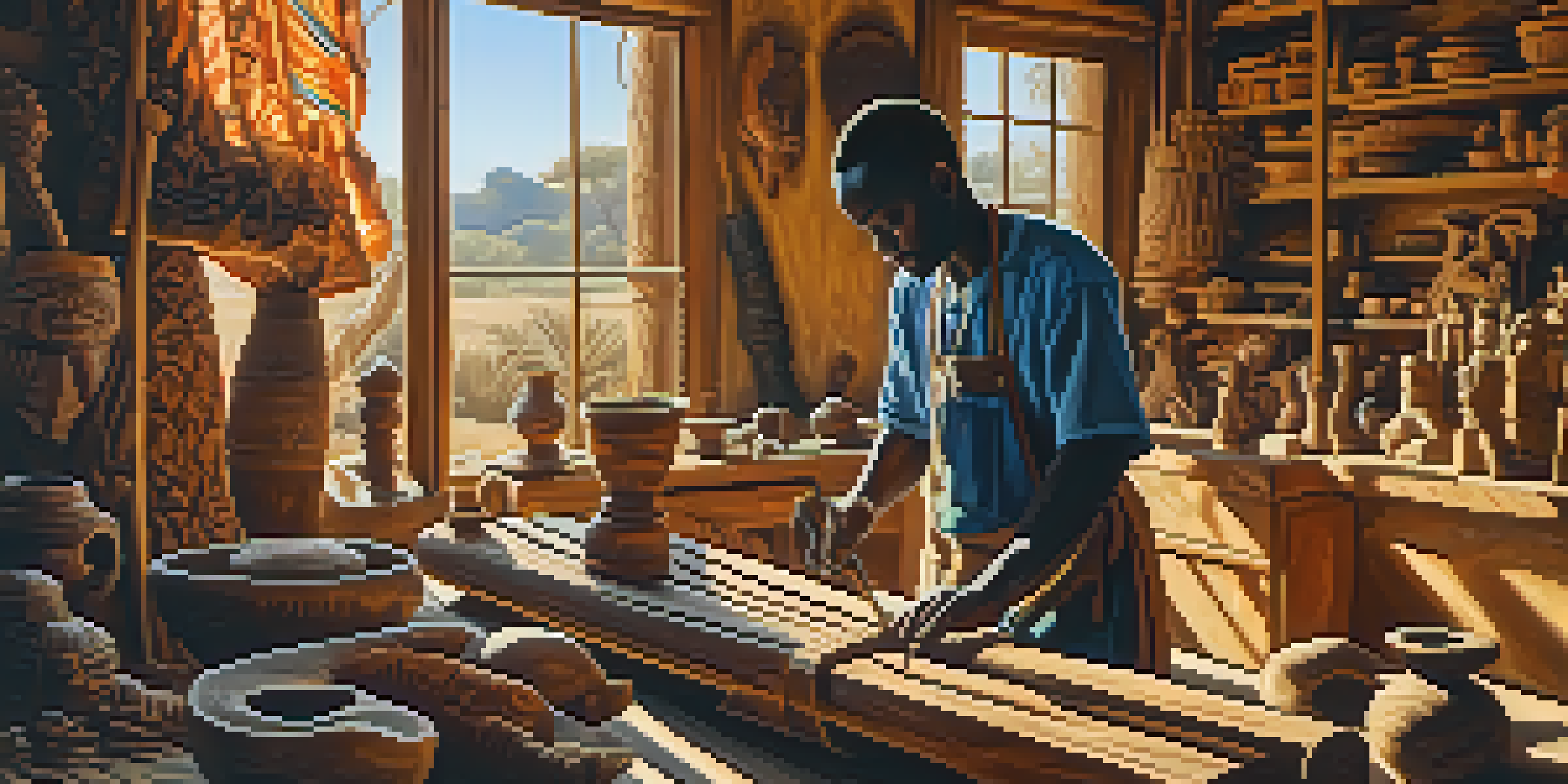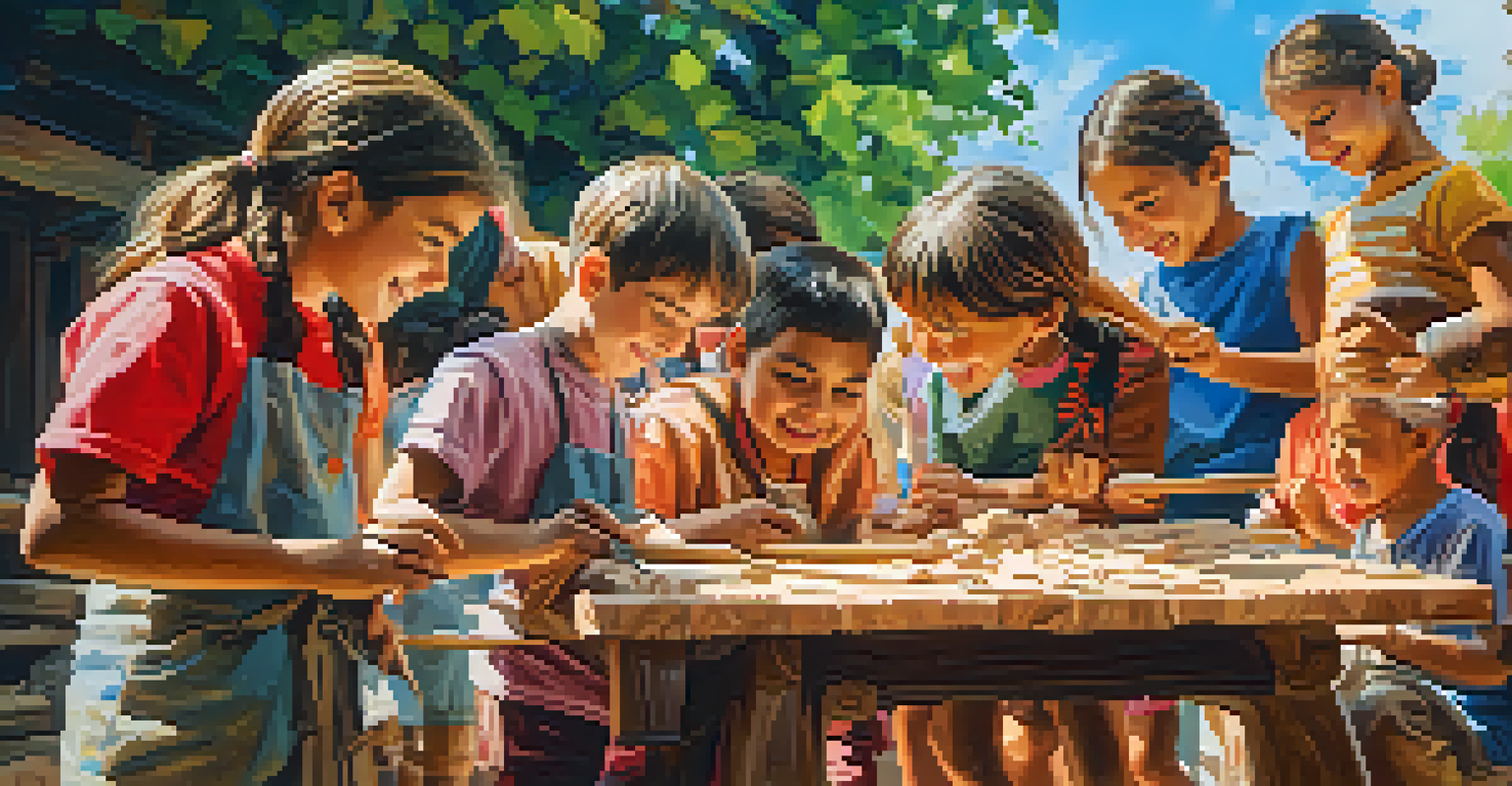The Role of Wood Carving in African Storytelling Traditions

Understanding the Significance of Storytelling in Africa
Storytelling in Africa is more than just entertainment; it's a vital means of preserving culture, history, and values. Through tales passed down generations, communities share moral lessons and explanations of the world around them. These stories often reflect the community’s identity, serving as a bridge between the past and the present.
Storytelling is the most powerful way to put ideas into the world today.
In many African cultures, oral traditions are integral to social cohesion. They create a shared sense of belonging and understanding among people. Just as a tapestry weaves together different threads, storytelling binds the community through shared experiences and collective memory.
Moreover, storytelling is frequently accompanied by artistic expressions, making it a multi-faceted cultural practice. This is where wood carving comes into play, enhancing the narrative experience by providing visual representations of the stories told.
The Art of Wood Carving: A Cultural Heritage
Wood carving is a revered art form in many African cultures, often passed down through generations. Carvers use traditional techniques that have been honed over time, turning simple pieces of wood into intricate works of art. This craftsmanship reflects the carver's skill, creativity, and deep connection to their cultural roots.

Different regions in Africa boast unique styles of wood carving, each with its own symbolism and purpose. For example, some carvings may depict animals, which can represent various traits or cultural beliefs, while others might illustrate human figures, telling stories of ancestors or legends.
Storytelling Preserves Culture
In Africa, storytelling is a crucial method for preserving culture and history, passing down moral lessons and community identity through generations.
Through these carvings, the stories of the community are not only told but also preserved. Each piece can serve as a visual storytelling tool, allowing those who encounter it to engage with the narrative in a tangible way.
Symbolism in Wood Carvings: More Than Meets the Eye
Wood carvings often feature rich symbolism that conveys deeper meanings. For instance, a carved figure of a bird might symbolize freedom, while a serpent could represent wisdom or transformation. These symbols serve as visual shorthand, encapsulating complex ideas within a single image.
Art is the most beautiful of all lies.
Understanding these symbols can provide valuable insights into the beliefs and values of the culture. Just as a painting might evoke emotions, wood carvings can provoke thought and reflection, inviting viewers to explore the stories behind them.
This layered storytelling approach enriches the narrative experience, allowing for multiple interpretations and connections. As viewers engage with the artwork, they embark on a journey through history, culture, and shared human experiences.
Wood Carving as a Tool for Education and Preservation
In many African communities, wood carving plays a crucial role in education, particularly for younger generations. Through interactive storytelling sessions, children learn about their heritage and cultural values, often while learning the art of carving themselves. This hands-on experience fosters a sense of pride and continuity.
Carvings can also serve as teaching tools, illustrating key concepts or moral lessons embedded within stories. For example, a carved representation of a wise elder might accompany a tale about the importance of wisdom and respect for elders in the community.
Wood Carving Enhances Narratives
Wood carving serves as a visual storytelling tool that enriches African narratives, allowing communities to engage with their cultural heritage in a tangible way.
This educational aspect of wood carving ensures that stories are not only told but actively experienced, making them more memorable and impactful for younger audiences.
The Intersection of Tradition and Modernity in Wood Carving
As with many art forms, the world of wood carving is evolving, influenced by modern techniques and ideas. While traditional methods are still cherished, contemporary carvers may incorporate new tools or styles, creating innovative pieces that resonate with current audiences. This fusion of old and new is a celebration of cultural adaptability.
Modern wood carvings often reflect contemporary issues or themes, bridging the gap between past and present. As artists explore new narratives, they invite broader audiences to engage with African storytelling traditions in fresh ways.
This intersection also opens up opportunities for dialogue and exchange, allowing for a richer understanding of African cultures on a global stage.
The Role of Wood Carving in Community Identity
Wood carving is not just an individual pursuit; it is a communal activity that fosters collaboration and solidarity. Many communities come together to create large-scale carvings for festivals or important ceremonies, reinforcing social bonds and collective identity. These communal projects often reflect shared values and aspirations.
Furthermore, the presence of wood carvings in public spaces can enhance a sense of pride among community members. They serve as visual markers of cultural heritage, reminding people of their roots and history.
Challenges and Innovations Ahead
While traditional wood carving faces challenges from modernization, there are efforts to revitalize this art form, ensuring the preservation of cultural practices for future generations.
In this way, wood carving becomes a powerful tool for affirming cultural identity, ensuring that stories and traditions continue to thrive in an ever-changing world.
Preserving the Future: Challenges and Opportunities
Despite its rich heritage, the art of wood carving faces challenges in today's rapidly changing world. Globalization, urbanization, and the rise of digital media can overshadow traditional practices, risking the loss of invaluable cultural knowledge. However, these challenges also present opportunities for innovation and revitalization.
Efforts are being made to promote wood carving as both an art form and a vital cultural practice. Workshops, exhibitions, and educational programs aim to engage younger generations, ensuring that these traditions are not only preserved but also celebrated.

By embracing modern platforms and techniques, wood carvers can reach wider audiences, sharing their stories and art with the world. This not only helps keep the tradition alive but also fosters appreciation and respect for Africa's rich cultural heritage.